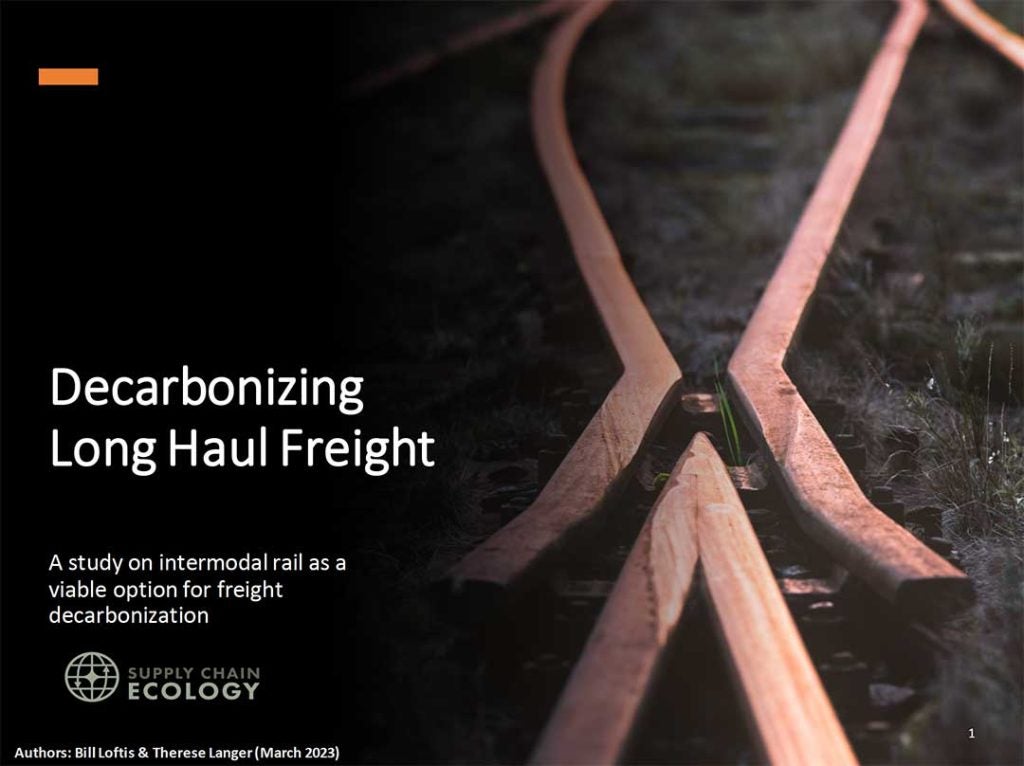Riding the Rails: Can Intermodal Transport Help Decarbonize Freight?
By Josh Torres and Jenny Mandel
Freight transport is at the leading edge of a decarbonization revolution, with heavy-duty electric trucks rolling onto US roads as companies work to push health- and climate-harming emissions out of the supply chain. But there’s an often-overlooked opportunity to move some of the truck-load freight more efficiently and cost-effectively – by shifting truckloads to rail through the use of intermodal transport.
Intermodal freight movement offers several advantages over trucking. First, according to Union Pacific, rail is 3-4 times more fuel-efficient than trucks. This translates to higher carrying capacities and longer reach that give rail a lower cost-per-ton-mile compared with long-haul trucking. The corresponding climate impact is an estimated 75% emission benefit for conventional rail over trucking. Both sectors are moving toward electrification to eliminate tailpipe emissions and enable further carbon reductions through the use of renewable electricity, but the efficiency advantages of rail transport will continue to mean less clean energy resources dedicated to freight with the use of intermodal transport versus trucking alone.
Some efforts to take advantage of rail’s higher efficiency are already under way. Rail is a key technology in the US National Blueprint for Transportation Decarbonization, which contains avenues to direct investment to increase rail efficiency and improve system operations. The major rail operators – a group known as class I carriers that includes BNSF, Canadian National, CPKC, CSX, Norfolk Southern, and Union Pacific – have all adopted climate targets and transition plans, with a range of time horizons and levels of ambition. Public funding and emerging technologies are becoming increasingly accessible, for example through Department of Transportation discretionary grants and zero-emission rail vehicles like those being developed by Parallel Systems. Expanding intermodal capacity would capture greater benefit from those efforts.
Reimagining the US rail system
New research by Supply Chain Ecology, commissioned by EDF, lays out a comprehensive vision to unlock the potential of intermodal freight. This could be achieved by focusing on five key points:
- Integrate short-line and class I rail networks: Today, there is very little intermodal hand-off between class I carrier routes and short-line rail. Haulage agreements, where short-line and class I carriers agree on cargo exchange, can generate cost savings for first- and last-mile delivery and reduce the distance traveled by trucks carrying cargo from a rail terminal to its final destination.
- Develop intermodal hubs: Increasingshort-line rail use requires building out more intermodal hubs to enable rail-to-truck transfers. Small intermodal hubs require minimal resources: a single short-line hub could sit on 25-50 acres and cost around $5-10M per hub, in contrast to the far larger hubs serving class I lines that can cost $100-150 million. A commitment of $1 billion could build 100 facilities or more, greatly expanding intermodal rail infrastructure and access.
- Upgrade freight technology: New technologies are increasingly available to improve operational efficiency. These include autonomous electric bogies[1] that address fuel efficiency and labor constraints, data platforms that enhance load traceability, and control systems that improve traffic management.
- Push for better freight intelligence tools: Many shippers lack the detailed reliability and cost data to support mode decisions. Freight market intelligence tools should be developed to improve shipper data quality and more effective mode decisions.
- Update regulations: Congress and the federal Surface Transportation Board can facilitate the integration of short-line rail and class I networks by updating performance and service standards.
This new research suggests how successfully integrating class I and short line rail into an updated intermodal ecosystem could usher in transformative gains for the industry, while simultaneously reducing greenhouse gas emissions from the freight sector.

Decarbonizing Long Haul Freight
A study on intermodal rail as a viable option for freight decarbonization.
A role for investors
As logistics companies are increasingly called upon to decarbonize, intermodal has an important role to play. Missing this opportunity risks a more costly path to net zero emissions and slower progress in the transition. For investors in the companies exposed to those risks, including rail carriers and the shippers that use their services, engaging with portfolio companies on how intermodal fits into their net zero strategy is a means to understand company climate performance and support competitive positioning as the industry evolves. Enhancing intermodal rail may be, when it comes to freight transport, the path of least emissions.
[1] A bogie is a metal frame with wheels that serves as a platform to carry the train car or locomotive